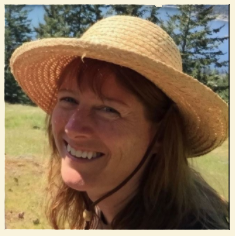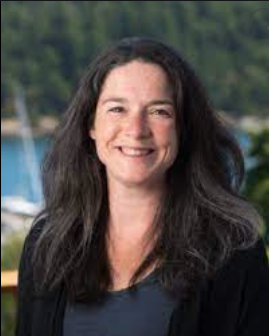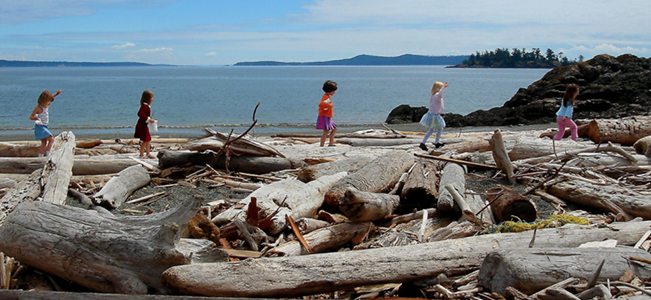||| FROM SHARON ABREU, SPECIAL TO theORCASONIAN |||
The San Juan County Council has moved the Environmental Resources group from a division of the Department of Public Works to the new, independent Department of Environmental Stewardship, elevating the status of this team to be on par with Parks & Recreation, the Land Bank, and Public Works. The new Department has a stellar team, and here you’ll meet a few of them

Kendra Smith, Director of Environmental Stewardship / Deputy Public Works Director
In June, the County Council appointed Kendra Smith, formerly manager of Environmental Resources under Public Works, as the Department of Environmental Stewardship’s director.
“I’m very excited about the new department,” Smith told theOrcasonian. “Environmental
Stewardship” captures the essence of the work we do in freshwater, the marine environment, solid waste, climate and sustainability, and cultural resources. With two new positions, Climate & Sustainability Coordinator and Environmental Inspector, the Department has a team of experienced people who will bring these efforts to a new level for the County.”
Smith said the new department really won’t change the team’s core work but expand and better integrate it. The two new positions are significant. Environmental inspections, funded via the Clean Water Utility and development inspection fees, will help to ensure that the environmental permit approvals processed through the Department of Community Development (DCD) are implemented as approved.
The Climate & Sustainability group will focus on the San Juan County Climate Resolution 20-2020, passed by the County Council, and creating an annual progress report on local actions.
“We have the climate resolution and a list of things we’re working on,” Smith said. “We want to raise the bar, and that’s what the Climate Action Plan is for. We need to establish what that looks like from where we are now and determine what the Climate Action Plan will add to those efforts. We need to find out how far we are from the community’s goals in a climate action planning process. We’ll have to go after some grant funding. It’s challenging to find funding for the Climate Action Plan. There is money for climate action for specific projects, but little for planning or staffing,” she explained.

Acknowledging the recent impacts of severe weather on Orcas, Smith said, “The Killebrew Lake Road failure last year cost the County half a million dollars.” And that’s just one of four we’ve had in the last two years. The road to adapting to climate impacts will be an expensive one.”
Smith and her team suggested the name “Environmental Stewardship” to the County Council to emphasize that protecting the environment and engaging the community to be part of these solutions are both priorities.
“We’re a small team and we can’t do it alone,” she said. “We’re thinking about the structure – about how we get this work done at scale. We’ll be engaging the community and encouraging people to participate in activities ranging from composting to planting trees along riparian corridors to picking up marine debris.”
Angela Broderick, the Department’s Climate & Sustainability Coordinator, has a background in sustainability, tourism and communications. Broderick is excited about bringing residents together around this work. She has started working on the Sustainable Tourism Management Plan with the Lodging Tax Advisory Committee (LTAC) and will also coordinate a new Climate & Sustainability Advisory Committee, which will look at the climate resolution, make recommendations for focusing our priorities moving forward, and invite citizen participation.
Broderick explained that the new advisory committee is taking shape and will likely consist of a core working committee along with liaisons from other County advisory committees to tie into their specific areas of expertise. She wants to encourage already-existing committees in the county to think through the lens of climate and sustainability issues. The committee will bring together local people forming a multi-faceted perspective, helping identify which actions need to be prioritized and what strategies can make them happen. Applications for membership on the committee will be available soon.
“I’m interested to listen and be open to where this might lead. Even if people don’t want to apply for the committee, if they’d like to be a part of the process, I’m really interested to hear what’s important to them. I’m encouraged that there’s such a strong connection to place in the county,” Broderick said. “While environmental stewardship is a personal passion of mine, I feel like I’m in good company. The team in my department are really dedicated to this work, and they’re extremely qualified.”
Meanwhile, Broderick is helping prepare for the launch of a series of public engagement sessions in 2022 to help shape a Sustainable Tourism Plan. “I look forward to helping facilitate community dialogue around what the issues and opportunities are, what we think tourism should look like here, and how we achieve that,” Broderick said. “Caring for the environment is caring for people, too. I think the tourism work will help address that.”

Katie Fleming
Another addition to the new Department is Katie Fleming. Longtime Community Engagement Director at the Friends of the San Juans, Fleming is now the “Solid Waste Coordinator” in the Department of Environmental Stewardship. Her first two priorities are: (1) Getting compost facilities planned and operating in the County, and (2) reducing single-use plastics.
“The urgency of the climate crisis has made me want to make change in a bigger way,” Fleming said. “I want to support programs that help our community participate in solutions to reduce the carbon footprint of our waste stream. The Department is full of passionate people who want to make a difference. It’s a very collaborative team. There are also ways for citizens to inform what’s going on within our programs. In fact, many of the citizen advisory committees in the Department have open seats, and we’re looking for people to apply.”
Currently, the Department of Environmental Sustainability consists of:
- Kendra Smith, Director of Environmental Stewardship
- Byron Rot, Environmental Stewardship Project Manager
- Dr. Frances Robertson, Marine Program Coordinator
- Marta Green, Puget Sound Recovery Coordinator
- Sam Whitridge, Salmon Recovery Coordinator
- Krista Davis, Stormwater Engineering Technician
- Angela Broderick, Climate & Sustainability Coordinator
- Katie Fleming, Solid Waste Coordinator
- Steve Krueger, Environmental Inspector
You can learn more at the Department of Environmental Stewardship website, Facebook page, and Team page.
**If you are reading theOrcasonian for free, thank your fellow islanders. If you would like to support theOrcasonian CLICK HERE to set your modestly-priced, voluntary subscription. Otherwise, no worries; we’re happy to share with you.**









Thank you for this information, Sharon. I am sure that many of us have been wondering about this new department, and your article informs all of us.
We live at the end of Barnacle Lane on Obstruction Pass. Our bank is eroding badly. Who can we consult with for our bank protection options? thanks, Mike Bosworth, phone 360-376-3320.
I have always wondered about job creation in new projects. Is there an effort to employ people from islands other than San Juan? County jobs tend to be stable and valuable as people live, work, buy groceries and services and participate in their local individual island community more than in other island’s communities. What is the “other”” island participation in this new development? Just wondering: no criticism implied or intended.
Mike, The Friends of the San Juans can help with shoreline technical assistance. Call the Friends’ office at 360-378-2319.
I am reading this article so long after it’s publication, I fear I won’t get a response. But I am curious if this Department will have any influence on projects originating from other departments. For example, a project like The Prune Alley Project, could that project have been examined for suggestions and ideas to lower its environmental impact, ways trees might have been saved, even ways its noise and dust impact could have been managed better? From an untrained eye, it didn’t look like any aspect of the project was operating differently than it would have in the 1950s. The center of its operations was placed right across from the largest residential building on the block. If it had been placed a block further down, the noise and dust directly under their windows might have been lessened and they might have been disturbed a little later in the morning and the focus would have shifted away from that building sooner than 5 p.m., as much noise and dust was created by equipment leaving from and returning to that central station. So much of environmental stewardship is about mitigation of harmful practices, is it not?